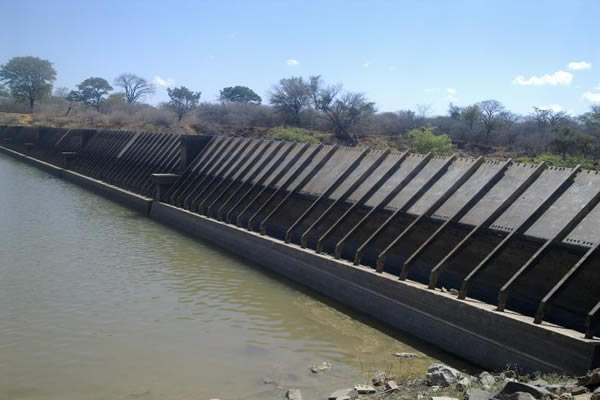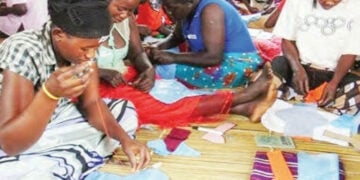Constructed by the federal government essentially to provide potable drinking water for households and commercial use and boost agriculture, the Doma dam was commissioned amidst fanfare and optimism by residents who view it as a solution to the lingering water scarcity.
The dam is a product of the defunct green revolution policy of the former General Olusegun Obasanjo/President Shehu Shagari administrations and was initiated with the Bakolori Dam of Sokoto state.
Interestingly, the Doma dam is larger than its Bakalori counterpart and was designed to provide two million cubic of water while serving as a source of irrigation farming for the hundreds of farming communities around Doma community and its environs.
Situated at about 7 kilometers from Doma town, the headquarters of Doma local government, the dam is about 31 Kilometres away from Lafia the Nasarawa state capital.
Although the construction of the dam began during the Obasanjo through to the late Shagari era, the General Ibrahim Badamasi Babangida government completed it. The late General Sani Abacha commissioned it on September 21, 1995.
Upon completion, pipes were laid even as irrigation facilities were duly provided to support the irrigation farming with an arable land of 200,000 hectares earmarked.
However, years after the fanfare and optimism that greeted the commissioning, the dam has failed to serve the twin purpose of providing potable water for household/commercial use and irrigation farming.
The pipes are dried even as the irrigation component has been neglected and hence, not serving the essential purpose of boosting all year round agriculture.
Our correspondent who toured the dam site observed that it was in a state of neglect as evident in the undergrowth Shrubs and bushes. Water hyacinths have taken over some part of the water with weeds encroaching deep into the body of the water
Cobwebs have taken over the large room such that spiders have no space to, the decay also include the engineering installations as the entire premises has been overtaken by shrubs and thick grasses playing host to rodents and reptiles while the four mighty water pumps that did not supply water for sometimes stand firm in the pump house.
Upon completion and commissioning, residents of Doma community who have had to contend with long years of water scarcity, view it as a relief and an end to the dearth of portable drinking water. But it appears their optimism was wishful thinking as the project is currently not delivering on its plausible mandates.
Adegbo Omadefu is a resident of Doma town. He told our correspondent that the whole essence of the dam has yet to be fully realised even as he insisted that the neglect of the dam attest to the sad story of Nasarawa’s untapped potential.
“The idea of the dam was a good intention and aim to unlock the vast agricultural potentials of Doma and its environs but today, one may not be wrong to state that the multi billion naira project is a total waste of taxpayers’ money as the host community is not benefiting. The aim of providing water to Doma and its environs is not being achieved as the pipes have run dry for as long as one can remember. The pipes are in a rusty state with no water running on taps”.
LEADERSHIP Weekend gathered that for over six months, the Doma community has been without pipe borne water even though the dam has capacity to supply 2million cubic of water daily. Unconfirmed reports said the non-supply of water to the host community was because of the lack of diesel and breakdown of standby power plants.
Few metres from the pump house stands the project’s panel house, another installation for the complicated water engineering project where the small steel house is hardly visible from the thick grass and shrubs that have sandwiched it.
Apart from the thick tall grasses, there is a thick dust, which prevented one from identifying the colour of the equipment, which were exposed to scorching sun and rain. It is observed that farmers within the vicinity are using the area housing the equipment to sundry melon, maize and other farm produce.
It is disturbing that the dam, which is sixteen kilometers in length, appears to be wasting. With water content that was initially over 35 million cubic metres, the dam has not been put to any good use apart from fishing some years back, but currently the water content must have drastically reduced, because it has silted, the dam today is hardly two feet deep, and the base is obvious from sight.
We recall that the massive water works called the Doma Water Supply Scheme is an inheritance from the old water works of the defunct Plateau State, which was constructed by SCC Nigeria Limited.
Essentially, the Doma dam regulates the flows of the Ohina River in Nasarawa state. It is a multi-purpose dam with the primary purpose of irrigation farming and domestic water supply. There is domestic latent annual demand for power of around 163GWh, or close to 19MW of installed capacity in addition to commercial and industrial demand. A hydropower project in the vicinity will help in reducing dependence on costly and polluting options such as diesel generating sets.
Nonetheless, because hydropower projects are typically characterized by their capital-intensive nature, long gestation periods, predictable/ dependable power generation, and the depreciating cost of power generation, these characteristics have led to governments joining hands with private participants, with varying degrees of involvement, to develop hydropower projects globally. Development of the project via the PPP mode is considered the best possible option, while the build, own, operate, transfer model is recommended as the best methodology to attract private sector technical expertise and financial resources to develop and operate the hydropower plant at Doma dam.
In the face of heightened calls for diversification of the economy from over dependence on oil, it is alarming that Doma Dam and its potential for agricultural sustainability has suffered neglect by the federal government.
LEADERSHIP recalled that four years ago, the minister of Water Resources, Suleiman Adamu, while on a one day working visit to launch a graduate internship scheme in Nasarawa state, said the federal government was already working hard towards reactivating and putting the dam to full use.
Specifically, Adamu said the dam that will serve the purpose of irrigation farming would also offer employment to over 3,000 youth of the state who will be trained and supported for agro business.
Reflectively, under the then IBB administration, a firm, UTC was contracted to provide complete installation of the machinery needed at the engine house to pump water to farms: water pumps, panels and generators for power supply. Expectedly, pipes were laid from the dam up to Rutu, some distance from Doma. In all, 20,000 hectares of land around Doma was projected for gravity irrigation, but the administration of IBB saw to the laying of only 1,500 pipes, covering 1,600 hectares, to make up for a part of the Phase I. Even though UTC engineers tested the irrigation system, using the installed gravity system, the main pumps were not used.
The Phase I of the project was commissioned in 1988. Between then and 1998, a couple of skeletal farming activities took place, with crops like watermelon and maize grown on a small scale.
It was gathered that a onetime military governor of Benue State, Col. Idris Garba, cultivated 10 hectares of maize in Doma, using the skeletal irrigation system some years back.
However, the Phase I of the project did not stand the test of time, as the pipes began to burst because of high pressure from the gravity system, just as the usual Nigerian problem of inadequate funding hampered the general function of the project. Even the test run was done using alternate power arrangements – the three number 500kva generators with high diesel consumption leads to the abandonment of the fertile land meant for irrigation farming.
Even though the Dam was a product of the green revolution programme established during the General Olusegun Obasanjo/ Shehu Shagari era to boost agriculture production in Nigeria and by extension to also provide employment for the teeming youths, it has suffered serious neglect, which continues to impede its potential.
Lower Benue River Basin Development Authority Reacts…
The dam, being a federal government project, is controlled by the Lower Benue River Basin Development Authority (LBRBDA), an agency under the federal ministry of water resources. Engr Muhammad Addra is the Managing Director. He faulted the lack of power from the national grid to Doma dam as the reason why the dam is not being optimally used.
Addra however called on the Abuja Electricity Distribution Company (AEDC) to take advantage of the boosted electricity following the commissioning of Akurba substation by President Muhammadu Buhari to put the dam into effective use.
He said the reconnection of the 75 electric poles destroyed by vandals became necessary adding that the reconnection will ensured the prompt supply of potable drinking water to residents of the host community.saying (UNIDO) in partnership with LBRBDA is constructing Small Hydro Power Installation to generate 115 kilowatt to boost irrigation farming in the dam.
The General Manager added that UNIDO will do the technical aspect while LBRBDA would handle the civil structure which include the building of the pump house and the drilling of pipes and turbines.
Nasarawa Government’s Intervention
Conscious of the fact that the dam will serve its citizens and ultimately boost the food production in the state, the Nasarawa State government has at different times, been intervening in ensuring its optimal use.
It would be recalled that the administration of the late Governor Aliyu Akwe Doma awarded a contract to rehabilitate the water scheme with plans to extend water supply to neighboring towns and villages.
The Doma administration procured an additional 1000kva generator to keep steady power supply, raising the supply level from 1.5 million gallons a day, to the designed supply level of 3 million gallons per day
Also speaking during an official visit to Doma, the Nasarawa state deputy governor, Dr Emmanuel Akabe declared that concerted effort has been put in place by the state government to address the challenges hampering effective use of the Doma dam.
Akabe averred that the state government has taken concerted steps to address all the hiccups including erratic power supply that has stalled effective functioning of the dam. “On the issue of water supply, the state governor has approved and released.





